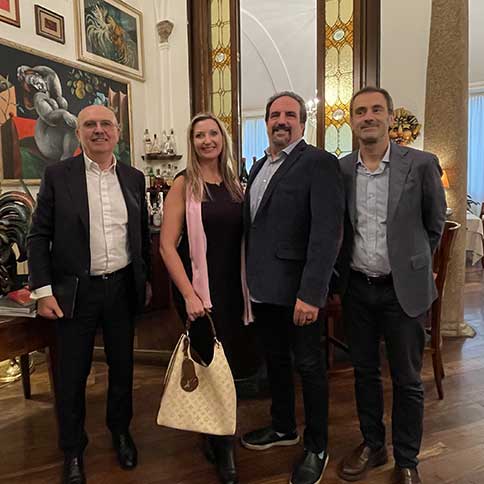Insights
A collection of our recent articles, white papers, webinars, reports and videos.
TAS @ NACUSO Network Conference

27-30 March 2023 | Wynn Las Vegas Resort
Las Vegas is set to host one of the most anticipated events in the credit union industry. The 2023 NACUSO Network Conference will offer an exciting lineup of Keynote Speakers to challenge, inspire and encourage you with their insights. Additional topics will cover regulatory issues, cybersecurity, cryptocurrency, state of the industry and CUSO hot topics.
We are thrilled to be part of this eventful moment as we showcase our latest products and services, as well as meeting with credit union leaders from across the country.
We invite you to stop by our booth to discover our advanced digital payments issuing platform that enables you to build business functionalities and deliver rich digital user experiences, across any channel, quickly and with minimum effort.
Contact us to learn more about our company and how we can help your credit union thrive.
We look forward to seeing you in Las Vegas!
What is embedded finance?

As part of the fintech market expansion over the last years, fintechs came up with new offerings to attract new segments in the market. Embedded finance enriches a non-financial consumer experience with a financial product. Financial products were traditionally offered by financial institutions but now they become part of a digital customer experience. It is integrated with one single platform to reduce barriers and simplify the life of users.
A company that provides non-financial services, such as an online shopping site, can offer a spot-on solution to accelerate the purchases of customers and improve the overall customer experience. Currently, retailers and gig economy companies are leading the way to embedded finance, however fitness clubs, gaming, non-profits and healthcare are expanding the use cases.
As reported in the recent study of Bain & Company in the US, transactions through embedded financial services amounted to $2.6 trillion in 2021 and will reach $7 trillion by 2026. Those numbers are an indicator of how customers are shifting their interactions with their finances, along with their customer experience.
Types of embedded finance
Most of the development in embedded finance takes place in products like deposits, payments, issuing, lending and insurance. These offerings form an easy integration with a consumer experience, it is straight forwarded to develop new use cases and it enables different opportunities for money movement.
Embedded banking
With embedded banking, also called Banking-as-a-Service, non-financial companies offer their users a virtual or IBAN account to hold funds and make payments. Embedded banking typically makes the most sense for sellers or service providers using a company's platform to conduct business. It is often also the basis to offer additional embedded finance products like payments, cards and lending.
For example, an acquirer can provide merchant settlements on their own IBAN accounts that can be used by the merchant to pay for supplies.
Embedded Payments
Taking out a debit or credit card, entering the PIN or tapping the card is a friction point that can cause consumers to abandon a digital purchase should their card not be handy. It is a total frictionless process in embedded payments as no plastic card is required.
The best example is the Uber taxi paying experience where the app stores the card data and payments are frictionlessly done when ordering a taxi.
Embedded payments are not only restricted to cards, but they can also give consumers the possibility to pay directly from their bank accounts.
An interesting global survey conducted by IDC revealed that within 2030, 74% of digital consumer payments will be made with platforms offered by non-financial institutions.
Embedded Card Issuing
Branded debit and credit cards exist for quite some time. As part of embedded finance, the use cases for using cards outside traditional retail payments are unlimited. For example, in the B2B space today expense management applications are able to issue one-time virtual T&E cards and are able to perform better spending controls in order to avoid that staff members use plastic corporate cards for private use.
Embedded Lending
In the past lending money for large purchases was done via credit cards or a traditional loan with a financial institution. The rise of new players and specialists in the fintech industry has led to significant growth in the lending area. Over the past few years, several BNPL platforms such as Klarna and Afterpay proliferated and gave consumers new opportunities to access funds easily when purchasing goods and services. The report concluded by Bain & Company estimated that by 2026, the market size brought by BNPL platforms will reach $265 billion. Their research showed also how customers are inclined to spend slightly more when using BNPL platforms, increasing conversion rates and revenues. Thanks to new accessible and frictionless technologies, embedded finance in lending is now becoming a significant part of the way consumers and businesses access funding.
Embedded Insurance
The continuous increase of data collected in all fields is not sparing the insurance market which collects information to be used for tailor-made and competitive policies. Embedded insurance programs differ from traditional insurance because they eliminate the insurance agent or broker for example when purchasing a new car or when using traditional payment methods. These new digital platforms enable traditional insurance companies to manage time-consuming and laborious activities such as claim registrations by offering a better customer experience, and technological platforms. We are also seeing new players outside of insurance using embedded finance to deepen customer relationships and drive loyalty. A great example is offered by Tesla, which offers competitive insurance policies when purchasing a new car, instead of being a separate part of the process.
How should an embedded finance platform look
Embedded finance platforms improve customer experience, journey and design to non-financial platforms. This is made possible thanks to an ecosystem made of partnerships between banks, technology providers, and distributors of financial products. Customers and businesses that use these modern interfaces can easily integrate their software thanks to open APIs and benefit from high levels of flexibility and configurability. Plus, a platform's embedded finance offering comes also with scalable and reliable micro-services, flexible workflow configurations and a centralized customized dashboard that permits companies higher dynamicity and a shorter time to market.
TAS Global Payment Platform (GPP): how should an embedded finance platform look
Hundreds of financial institutions choose the TAS Global Payment Platform (GPP) to provide a better payment experience and enable faster time to market. The GPP platform is suited to any ecosystem operator between banks, technology providers, and distributors of financial products to guarantee a great and seamless customer experience. We work with businesses in digital banking, BNPL, insurance, travel and payments thanks to a highly configurable platform with open APIs.
Our embedded finance offering comes with scalable and reliable micro-services, flexible workflow configurations and a centralized custom overview that permits companies higher dynamicity.
Cascade visited TAS Headquarters

We were very pleased to welcome Cascade’s CEO Spencer Schmerling and VP of Compliance Sarah Zeal to our Italian offices in Bologna, Rome and Milan.
As a US-based Banking-as-a-Service provider, Cascade provides Mobile Banking Services, Card Issuance, and Enrolment for card programs as well as a web-based banking portal, mobile app, and contactless payment capabilities.
Cascade was TAS's first US customer, and has launched a number of card programs with Mastercard and Visa using TAS's Card Issuing and Processing software. The project, which involved the integration into the American interbank clearing house (ACH), was completed in Q4 2020, and the first card programs launched in Q1-Q2 2021.
At the end of November, Spencer and Sarah came to visit TAS to get an update on the company and its offering and learn of the product and service roadmap.
“We are very happy with this visit and very impressed with the members of the senior leadership team who we met. We are very confident with TAS's deep knowledge of the payments sector and its ability to provide innovative solutions to the market”, Cascade's CEO Spencer Schmerling said.
“We appreciate the trust Cascade put in TAS and in our ability to create and deliver solutions and services around the world”, TAS CEO Valentino Bravi added.
“We enthusiastically welcomed Spencer and Sarah to Italy. We have built a strong partnership with Cascade that we are sure will lead to new interesting projects in the future” Peter Caiazzi, SVP Product Development, TAS International commented.
Fintech Finance interviews Mario Mendia

At Sibos 2022, we sat down with Mario Mendia, the Senior Vice President of International Markets at TAS Group, to discuss the emergence of payments-as-a-service and its potential in making banking more accessible to all possible demographics.
Looking at the trends at this year’s Sibos, Mendia is most excited about the digital developments in cross-border payments and CBDC, and the growing presence of cloud technology in major financial institutions.
TAS Group’s roadmap to innovation in global payments

TAS Group’s Mario Mendia, Senior Vice President - International Markets, and Andrew Quartermaine, TAS International Managing Director, join FinextraTV at Sibos 2022 to discuss TAS’s recent rebranding, their focus on innovation in their product strategy and their views regarding cooperation and competition in the crowded global payments landscape.
TAS @ UNITI Mobility Payment Forum 2022

5-6 October, Hamburg
Infraxis together with its Partner CCC welcome you to the UNITI Mobility Payment Forum 2022.
We’d be delighted to meet you and discuss your future needs in the areas of fleet card management, fuel payment processing and loyalty, which you can now select to be delivered as fully outsourced processing, SaaS or self-managed solutions.
Infraxis brings the “Build Your Own Card” paradigm to the area of fleet cards, allowing the full card lifecycle to be managed through secure APIs. Fleet card issuers can now focus on customer growth, retention and profitablity, using cards, apps and loyalty programs that seamlessly integrate to form a bespoke customer experience.
Visit Infraxis - CCC booth to discover PayStorm Fuel
TAS @ Sibos 2022

10 - 13 October | RAI, Amsterdam
Sibos is back in-person and TAS is again among the official exhibitors. We can’t wait to meet you in Amsterdam where SWIFT will host a full conference programme and exhibition, along with a wide range of networking events. The agenda will feature business leaders and topic experts from across the financial community and beyond, discussing the most impactful trends in technology, regulation, risks and sustainability. If you can’t make it in person, join Sibos virtually by connecting to the digital conference experience that will extend Sibos to delegates around the world.
Stop by our booth D76 to share insights on the latest trends on digital payments, liquidity management, payment schemes connectivity, open banking and much more.
TAS launches SoftPos to accept contactless payments from Android devices

Thanks to the agreement signed with Danish fintech SoftPay, TAS will enable the acquiring of contactless payments from Android mobile devices in Italy. The benefit provided by the SoftPos solution to merchants is simple and immediate: allowing to transform their phones into a ready-to-use payment terminal, without the need for additional certified hardware, thus reducing the heterogeneity and complexity of multi-device management at the point of sale.
The shopping experience is also improved for the buyer, who can complete the payment faster, avoiding long queues at the checkout.
The merchant APP is available on the Google Play Store and can be used in white label mode, or easily integrated with any APP already in use by the merchant.
The solution is certified with Visa and Mastercard, and is also available for mobile wallets - such as Apple Pay, Google Pay, Samsung Pay - whose payments are processed in a similar way to standard EMV transactions managed by traditional POS devices. For maximum user security, a specific certified component manages the typing of the PIN on Glass on the Android device, ensuring absolute confidentiality.
The SoftPos solution is offered by TAS to banking operators and their processors as a service in Cloud; in this way the impact on the Service Provider is minimal, avoiding to disrupt the infrastructures already in use to manage the POS channel.
Tuscany Region confirms TAS for the evolution of its digital platform IRIS

- administrative and technical enrollment of public bodies belonging to the Tuscany territory
- standardization of interfaces and integration with the national IO App system, with full reconciliation of receipts
- simplification of the payment experience of the users (citizens and businesses)
- integration with regional apps
- integration with the centralized booking system for public healthcare services (CUP) and the Pharmacies of the Tuscan Health Service.
Contact us
Get in touch to discover how we can help in achieving your business goals



